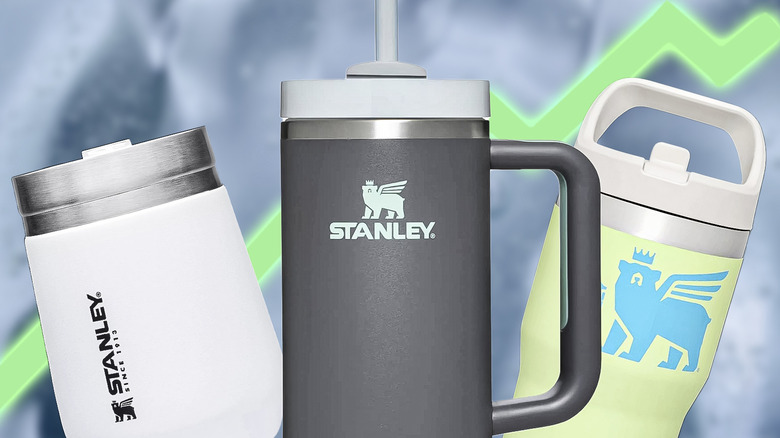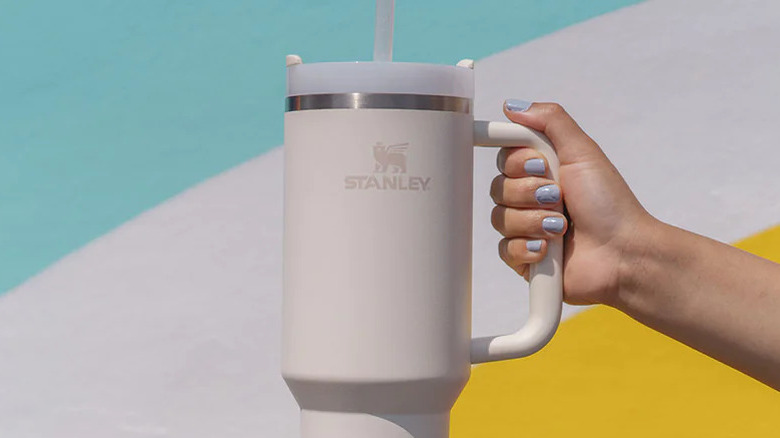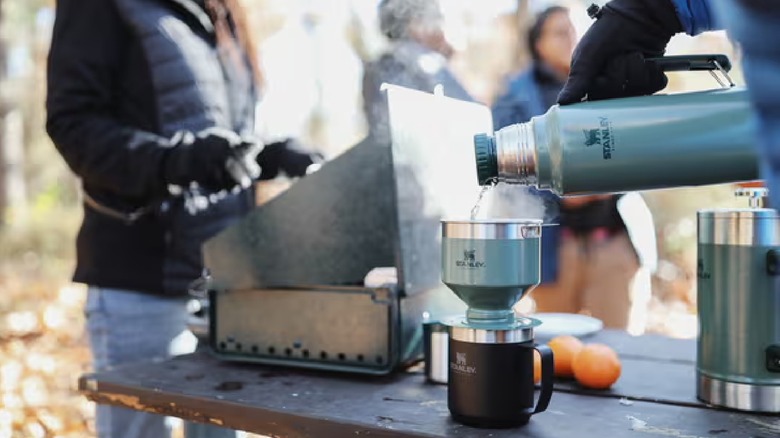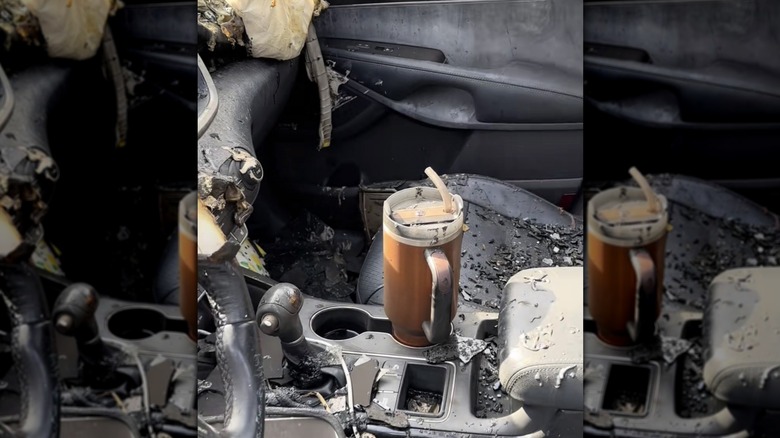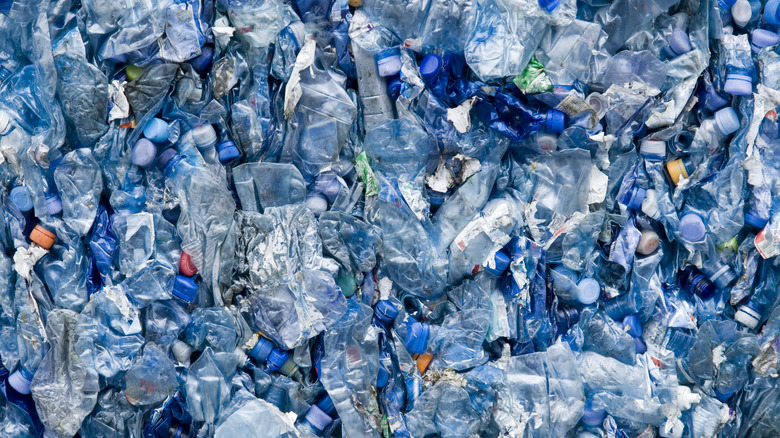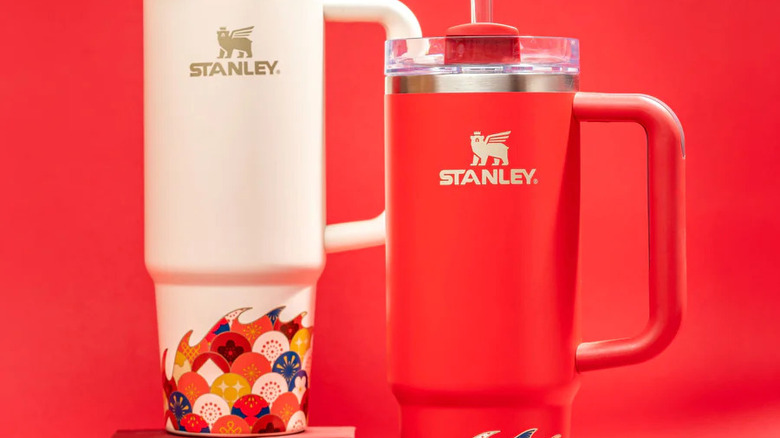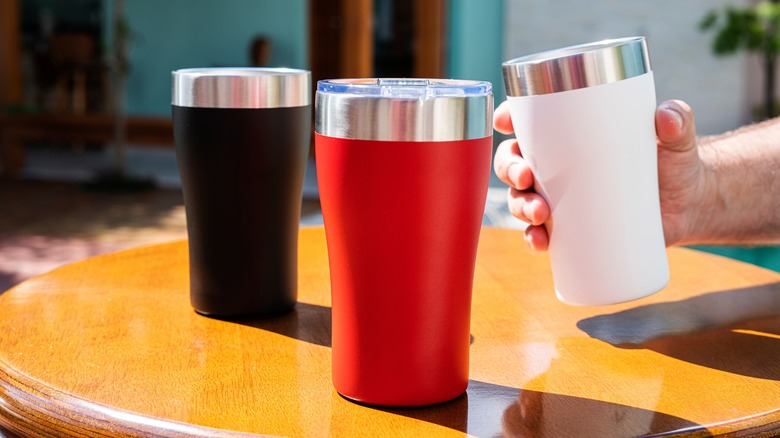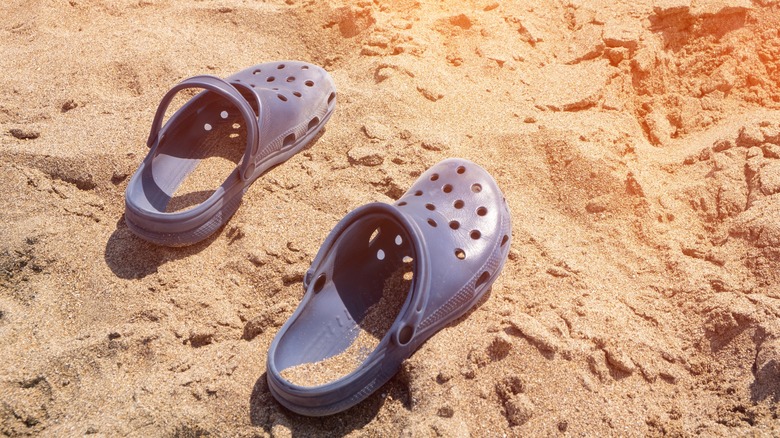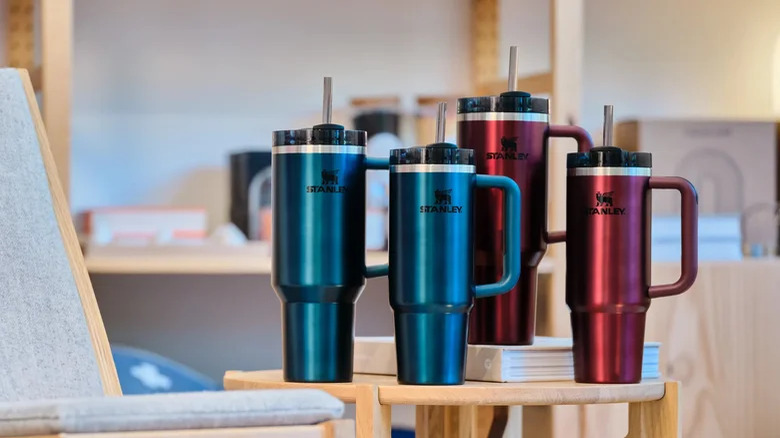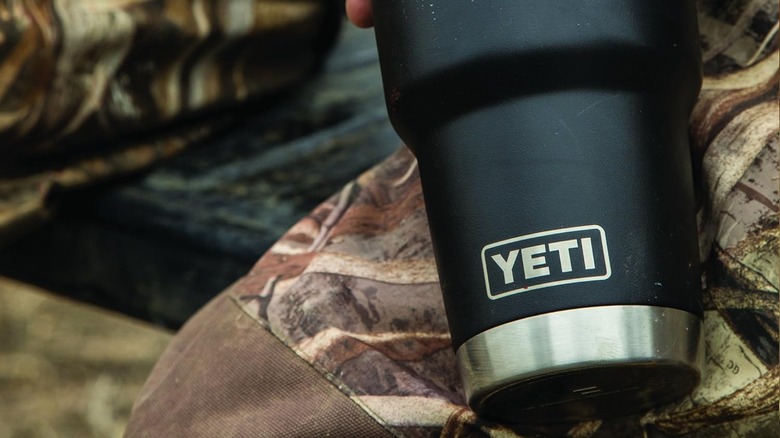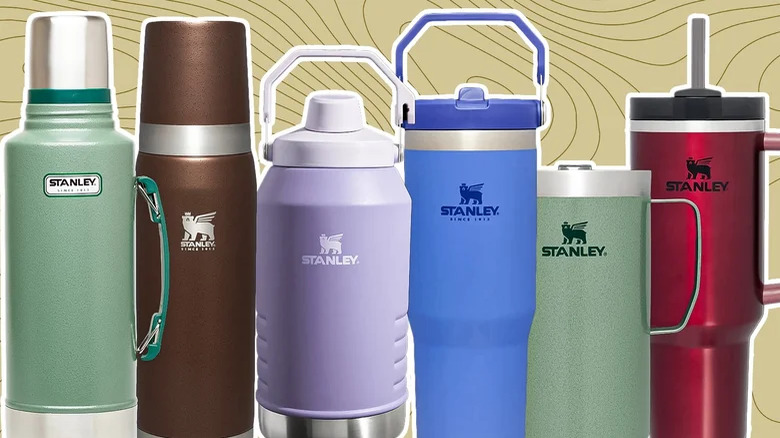What You Need To Know About The It Girl Stanley Tumbler Everyone Wants Right Now
In 2023, a tumbler-based trend gripped the United States. Everyone seemed to be after large, uniquely colored, insulated drinking vessels made by the long-established brand Stanley. Social media was also awash with a #StanleyCup hashtag which served to drive demand, give current Stanley tumbler owners a chance to flex, and more than likely confused a few hockey fans. But the story goes well beyond social media (and even the recent SNL skit about Stanleys). It involves some corporate planning, plenty of history, a lead scare, and a potentially large environmental benefit.
Stanley itself has a much more diverse product line than the 40-ounce vacuum tumbler everyone is now used to seeing and a history that stretches back over 100 years. However, before the current frenzy, it had occupied a few well-established niches. As of January 2024, the Stanley tumbler trend shows no signs of dwindling, so what's behind it all? What are the tumblers in question? And is it the designs alone that are driving things onward? Let's find out.
What is a Stanley tumbler?
A Stanley tumbler is a reusable drinking vessel sold by Stanley, a company founded back in 1913. Stanley's founder, William Stanley, is credited as the inventor of the all-steel vacuum bottle. Before this, and still to this day in some cases, vacuum flasks contained a lot of glass. This is far more fragile than steel, and such flasks are prone to breakage. While not everything Stanley sells is a flask, many of its products are vacuum-insulated to this day. The insulation process allows the products to keep liquids at a steady temperature, either hot or cold, for up to days at a time. Stanley currently offers a diverse range of products, though none of the things it sells are tools. That's a different company with the same name. Its current lineup includes "Iceflow" jugs and tumblers which range in size from 17 to 64 ounces, "Quencher" tumblers which range from 14 to 40 ounces, and various other items including hip flasks, coolers, and jugs.
The "Quencher" tumblers are the subject of a late 2023/early 2024 TikTok trend and might be what brought you to this piece in the first place. The most popular sizes on offer are 30-ounce and 40-ounce vessels. Said vessels are vacuum insulated, and perhaps most importantly have been the subject of several "limited edition" designs, including collaborations with Starbucks and Target.
Stanley products are pretty closely associated with camping
While its recent reputation seems to owe a lot to the tumbler's perceived collectability, Stanley's products actually have a pretty consistent customer base. Campers, hikers, and truckers have naturally bought plenty of Stanley products due to the brand's practicality and association with durability. A Stanley tumbler lends itself to the outdoors, or a long drive, for a number of reasons. Its large size allows you to pack enough liquid in there to see you through an extended period. Its vacuum insulation means that liquid is likely to retain its temperature all day. So if you want a hot coffee on a mountain top, then the brown liquid will be about as hot as it was when you poured it into the tumbler several hours ago.
Similarly, if you're hiking on a hot day and need to cool off with something, a tumbler full of ice and sweet liquid will be just as refreshing as the sun goes down as it was when you poured it in at dawn. If you're on a long-distance road trip, then a full 40-ounce tumbler of hot coffee should be all the caffeine you need. The flasks tend to be made from steel and are incredibly durable. So you don't need to worry about dropping or knocking it around on the trail. Stanley also offers a range of camping cookware and other products geared towards the outdoors.
Stanley Tumblers are known for their durability; one even survived a car fire
Stanley's products are known for being robust. They're essentially made from steel, so they aren't prone to shattering like other vacuum-insulated products that may use glass or plastic in their construction. As a result, people can keep a Stanley flask or tumbler for years, not take particularly good care of it, and still be left with something that functions perfectly well. In many cases, dropping or knocking one of the company's vessels against something will just result in some cosmetic scuffs, dents, or scratches.
A Stanley tumbler's durability was pushed to the extremes in 2023 when a fire tore through Danielle Marie Lettering's vehicle. Pretty much everything inside the car was destroyed, aside from a copper-colored Stanley tumbler. Not only did the Tumbler emerge from the fire intact, but it also continued to do its job as the blaze tore around it. Lettering's TikTok video after the fire showed that ice was still present inside the tumbler, despite everything that had happened.
Stanley was obviously pleased with the publicity that came with Lettering's TikTok video, as company president Terrance Riley quickly reached out offering to send her some products and replace the vehicle that was lost in the fire. Curiously enough, despite the survival, fire is one of the events that will void Stanley's lifetime warranty on its steel products.
The trend all started on Tiktok
As with many modern fads, social media, and specifically TikTok, is ultimately responsible for the Stanley Tumbler craze. Way back in 2022, The New York Times noted Stanley tumbler's popularity amongst the #Watertok community. Said community is a collection of generally younger Tiktokers who are interested in staying hydrated for the personal benefits it provides, while also reducing single-use plastic waste for the environmental benefits that provides, too. It was around that time that the "Quencher" overtook the iconic Stanley bottle as the brand's most popular product.
While the Watertokkers were partial to other tumbler brands, it was Stanley that ultimately stuck, and other social media events, like Danielle Lettering's car fire, only added fuel to the blaze. The trend eventually left the #Watertok community behind and became a phenomenon of its own, complete with its own #StanleyCup hashtag. Then, as is often the case, it spread to other social media platforms and made its way into mainstream news outlets.
There is an environmental consideration
While it's easy to focus on the cultural or financial aspects of the Stanley tumbler trend, it is still worth noting a major benefit of the tumbler's popularity. If people are drinking from a reusable vessel, like a Stanley Tumbler, then they are likely to be using fewer single-use plastics like plastic water bottles.
The reduction of plastic consumption was one of the ideas that drove the Stanley tumbler's popularity in the very early days of the trend and, intentional or not, the environment is likely still seeing some benefits from the cup's popularity. According to some studies, the average person consumes around a credit card's worth of microplastics per week. While the long-term health effects of consuming tiny bits of plastic are still uncertain, it's a figure many people would want to reduce.
Avoiding plastic bottles is one of the best ways we can reduce plastic waste, and stainless steel is one of the best materials a reusable water bottle can be manufactured from. So while the current trend may be odd to some people, there are some fairly objective positive notes to it.
This trend may be more style than substance
The Stanley tumbler itself is a good product. It keeps liquids at a set temperature for a long time, it's durable, and it's backed by a solid warranty. The environmental aspect is also a major reason to buy a Stanley tumbler or a similar product from another company. But if you look at the current trend, it isn't really about any of that.
Not all Stanley tumblers are created equal, or at least not in the eyes of the people buying them. The most sought-after vessels are the "limited edition" tumblers, which come in unique colors, with unique designs, and sometimes in collaboration with brands like Starbucks. Speaking to Business Insider, youth consumer trends analyst Casey Lewis described buying the tumblers as a "flex" and likened it to "collecting Beanie Babies." The analyst has also taken to X (formerly Twitter) and stated that people are "buying inclusion" when they purchase a Stanley tumbler, with many doing so just to fit in.
You have to check your Stanley Tumbler is authentic
Stanley tumblers tick a lot of boxes. They're highly desirable, limited editions can be very hard to get hold of, and at around $40 a piece, they're not exactly cheap. All of this makes the drinking vessel a prime target for counterfeiting. Counterfeiters manufacture something that looks close to the original product and sell it to often unsuspecting buyers. However, counterfeits are often cheaply made and use different methods from the ones used by an official manufacturer. This usually results in products that at best don't perform as advertised, and at worst can be downright dangerous.
In the summer of 2023, the Better Business Bureau issued a warning about fake Stanley tumblers. Criminals were selling copies of sought-after cups online, often at a price that was too good to be true. Unfortunately, what they received was a cheap knockoff. You can avoid scams like these by only buying things from trusted sources. If something is exclusive to Target, you know Target will be selling you the real thing. A small and shifty-looking website is unlikely to have a hookup with Stanley. Using payment processors like Paypal, or a credit card, can also add a layer of protection. If you're buying what you have good cause to believe is the real deal, and are sent an obvious fake, then it's usually possible to have the transaction refunded.
Stanley's popularity may not be as organic as you think
While TikTok and similar social media can take some credit, many analysts are pinning the company's recent success on one man's shoulders. Terence Reilly first shot to public attention by snowballing footwear brand Crocs' popularity. He achieved this through a series of collaborations with well-known celebrities, including the likes of Justin Bieber. Reilly left Crocs and took over as president of Stanley in 2020. Since then, he's managed to take somewhat organic situations, like the #Watertok trend, and the story of a Stanley surviving a fire, and used them to build viral success for his company.
Of course, it's all more complex than TikTok. Another parallel with Reilly's time at Crocs is the reliance on a scarcity model. People want things other people can't have, so all of those limited edition colors and collaborations are helping to drive demand — just like they did with the rubber footwear brand.
The real winner here is Stanley
In 2019, Stanley's annual turnover was around $73 million dollars. Following the success of the "Quencher" and the craze that followed, the company made more than 10 times that in 2023, per CNBC. So it's fair to argue that the real winners here are Stanley and the company's stakeholders.
At the time of publication, the Stanley tumbler hype is yet to show any signs of slowing down, and there are many long-term effects that the trend could create. So while a peak and decline of some kind is inevitable, it's likely that Stanley will go forward in a far stronger position than it was in just a few short years ago. The change in company direction may also stick. Crocs are still riding a wave of popularity that really started during Terence Reilly's tenure as head of marketing there. Revenue is still up drastically year on year as of late 2023. So even if Stanley's popularity peaked in early 2024, the future is still looking very bright.
Stanley tumblers do contain lead
In late January 2024, rumors and warnings about a Stanley tumbler-related health risk began circulating on social media. There were concerns that the popular drinks containers manufactured by Stanley contained lead, a heavy metal that is toxic to humans if ingested. It can be particularly harmful to children and may cause developmental issues.
Stanley soon came out and confirmed that the tumblers do in fact contain lead, but it takes the form of a pellet that is used to seal the product's vacuum chamber. Said pellet is then covered in steel, and the product would have to be severely damaged for the lead element to be exposed. In a statement to Today, a Stanley spokesperson said that the company's "engineering and supply chain teams are making progress on innovative, alternative materials for use in the sealing process."
Campaigners have claimed that the protective cap separating the cup's owners from the lead seal can break off far more easily than Stanley claims. If your cup does break, then it is advisable to stop using it and attempt to take advantage of the limited lifetime warranty Stanley attaches to its steel products, instead.
Alternative tumblers are available
Due to their current popularity, Stanley tumblers can be pretty hard to get at the time of writing. However, if you're not really interested in fads and are more interested in the practical side of things — you're in luck.
There are several other products on the market that are almost identical to Stanley tumblers in terms of function, construction, and practicality. Three popular brands that produce similar vacuum-insulated steel vessels are Yeti, Camelbak, and Tempercraft. If you just need a durable, reusable, drinking vessel that will keep liquid at a steady temperature for a long time, then something from one of these three manufacturers will serve that purpose perfectly well.
Stanley itself offers a wide range of products, many of which use its vacuum insulation process. Not all of those products are the focus of the current fad, which mainly centers on the "Quencher" line of Tumblers. So even if it has to be Stanley, you can still get an insulated cup without parting with half of your savings account on a reselling site or fistfighting your way through a mob at your local Target.
If you miss out, don't worry
The fad itself is also likely to die down. Cornell University points out that product trends adopted by young people have very short lifespans before fading away in place of something else. If you're over the age of 20, you can probably think back and picture several trends from your own childhood that peaked and faded much like the Stanley tumbler trend will. As for what's next, who knows? By mid-2024, TikTok users and other trendsetters may be camping out in the hope of snagging a particular brand of backpack, a ridiculous-looking hat, or a toy that turns out to be life-threateningly dangerous once its popularity hits the headlines.
When that happens, the collectible Stanley mugs will probably be relegated to a shelf or a cupboard where they may inspire some fleeting memories in several years, or might otherwise be completely forgotten about. That is unless their practicality is enough to spare them the trend graveyard, and they manage to maintain a spot as many people's daily drinkers even when the hype has long since passed. We'll just have to wait and see.
